Feature Benefit Selling In a Nutshell
Feature benefit selling means showing customers what your product will do FOR THEM, not just listing what your product has. Instead of talking about features like “one-click setup,” you explain the benefit: “sell in 1 minute instead of spending hours figuring things out.”
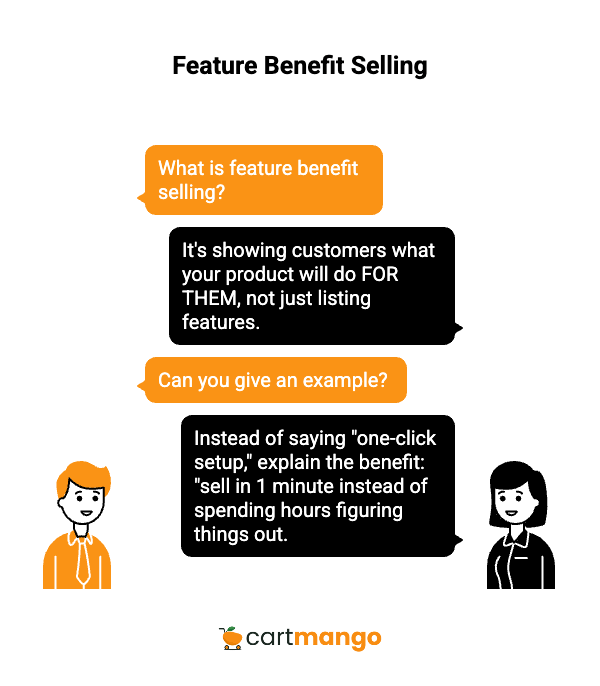
–
For the F-B-O Ladder Framework, jump to this section.
For the implementation plan, go here.
–
You just finished what felt like the perfect product demo.
Your prospect nodded, asked good questions, and seemed genuinely interested. They said they’d “think about it” and get back to you.
That was three weeks ago. Radio silence.
Most likely, you focused on what your product does instead of what it accomplishes for the buyer.
When you understand feature-benefit selling, you’ll convert more sales by speaking directly to outcomes, not mechanics.
Here’s what you’ll walk away with after reading this blog post:
- A proven F-B-O Ladder Framework
- A 4-step implementation plan
- A simple checklist to make sure you create banger copy
You’ll never lose another prospect to the dreaded “we’ll think about it” reply.
Why Benefits > Features
I’ve seen brilliant products get rejected. Not because they weren’t good enough, but because the seller couldn’t bridge the gap between functionality and value.
It’s like watching someone try to sell a drill by talking about the motor specifications instead of the perfectly round holes it creates.
Here’s the truth:
Buyers make decisions with their emotions first, then backfill with logic later. When you lead with benefits, you’re speaking their language.
Benefit-focused messaging improve conversion rates by connecting directly to desired outcomes.
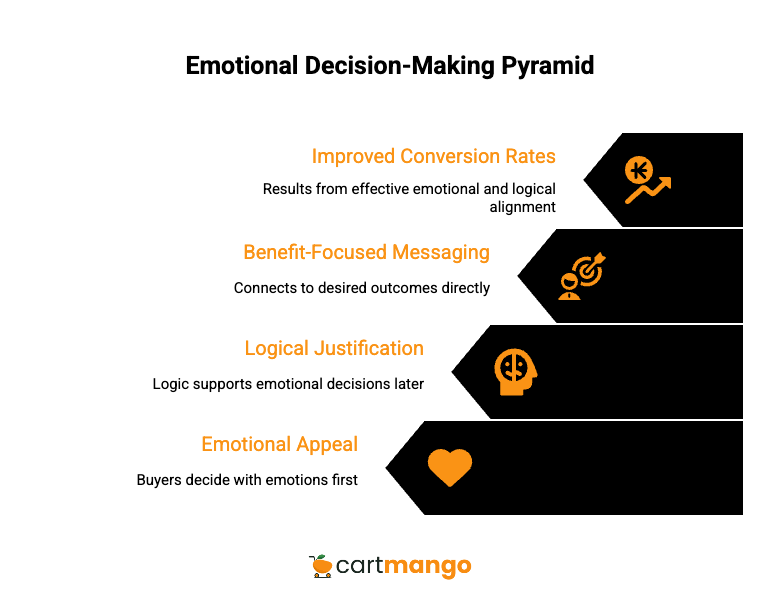
The average website converts between 2.35% and 5.31% of visitors (Source: WordStream). Benefit-driven copy helps you reach that upper range by removing friction from the buying process. Companies in the top quartile consistently lead with outcomes, not specifications.
Think about your last major purchase.
You didn’t buy a car because it had a V6 engine. You bought it because you needed reliable transportation to get to work without breaking down on the highway. That relief you felt imagining stress-free commutes?
That’s the emotional trigger benefits create.
Real testimonials and proof points can lift conversions by up to 34% (Source: Visual Website Optimizer) when they show the benefit in action. People want to see themselves in your success stories. They need to visualize their world after using your product.
Consider this: when someone buys project management software, they’re not buying task lists and Gantt charts. They’re buying the peace of mind that comes from knowing nothing will fall through the cracks.
They’re buying the satisfaction of leaving work at 5 PM instead of staying late to catch up on forgotten tasks.
The F-B-O Ladder Framework
It’s called the F-B-O Ladder because it moves you up from basic functionality to real value.
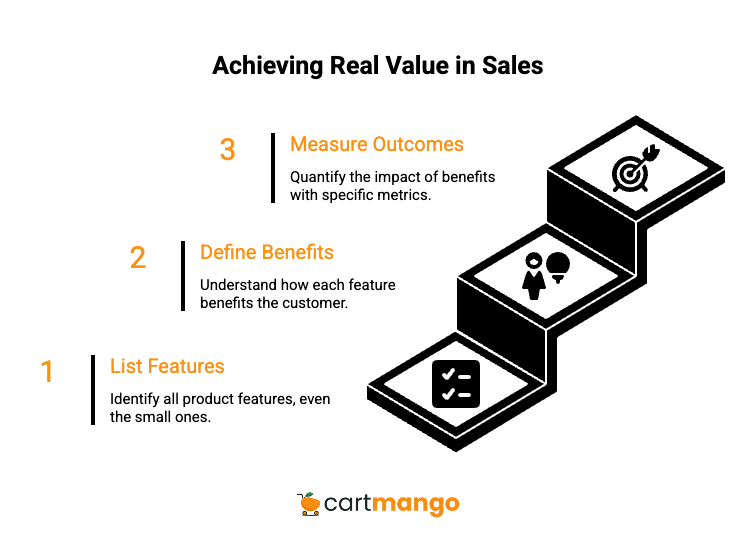
Every successful sales conversation follows this progression, whether you realize it or not.
Feature (What) | Benefit (Why It Matters) | Outcome / KPI (Proof) |
|---|---|---|
One-click setup | Eliminates manual configuration | Launch in minutes, not hours |
Real-time analytics | Immediate performance insight | Faster optimization decisions |
Automated compliance | Removes legal guesswork | Lower risk of fines |
Custom branding | Professional appearance | Higher trust and credibility |
Mobile-responsive design | Works on any device | Access anywhere, anytime |
Automatic backups | Data protection | Zero risk of losing work |
Team collaboration tools | Seamless communication | Projects finish 30% faster |
Here’s how to use this ladder:
Start by listing every feature your product offers.
Don’t hold back. Get everything down on paper first. I mean everything – even the small features that seem obvious to you.
Next, ask yourself “So what?” for each feature.
This forces you to think like your customer. What does this feature actually do for them? Write that down in the benefit column. Push yourself here. The first answer is usually too surface-level.
Then comes the crucial third step:
Ask “What does that benefit accomplish?”
This is where you capture the measurable outcome. Maybe it saves time, increases revenue, or reduces stress. Get specific with numbers when possible. Vague benefits don’t stick in memory, but specific ones like “30% faster” do.
When you write marketing copy, focus primarily on columns two (benefit) and three (outcome).
The feature itself should support the benefit, not lead it. Your prospects don’t care about your one-click setup until they understand it means they can go live in minutes instead of wrestling with complicated configurations for hours.
Keep your proof points realistic. Avoid promising “10x” improvements unless you have rock-solid documentation. Credibility beats hyperbole every time. I’ve seen too many companies destroy trust by overpromising and underdelivering.
This framework works because it mirrors how people actually think about problems and solutions. They start with a desired outcome, then look for the path to get there. Your job is to build that bridge clearly and convincingly.
Your 4-Step Implementation Plan
Let me walk you through the exact process I use to transform feature lists into conversion-focused messaging.
Step 1: Inventory and Tag Everything
Create a spreadsheet with four columns:
Features, Category, Priority, and Customer Language.
List every single feature your product offers. Don’t edit yourself yet. Include the obvious stuff, the hidden gems, and even the features you’re embarrassed about.
Tag each feature as either “Speed” (saves time), “Revenue” (makes money), or “Peace of Mind” (reduces risk/stress). Some features might fit multiple categories – that’s fine. Note all of them.
Add a priority column: High, Medium, or Low. Base this on how often customers mention each feature in sales calls or support tickets. The features that solve the biggest headaches get high priority.
Below is an example of what it’d look like for my CartMango tool:
Feature | Category | Priority | Customer Language | Proof Point |
|---|---|---|---|---|
One-click checkout setup | Speed | High | I don’t want to spend all day setting this up | Live in under 1 minute |
Mobile-responsive design | Speed, Revenue | High | My customers are mostly on phones | 60% higher mobile conversion |
Digital product delivery | Speed, Peace of Mind | High | Deliver courses automatically | Instant delivery, zero manual work |
Secure payment processing | Peace of Mind, Revenue | High | Keep customer payments safe | PCI compliant, 99.99% uptime |
Order bumps | Revenue | High | Increase my average order value | Increase AOV by 23% on average |
Email automation triggers | Revenue, Speed | High | Send emails automatically | Increase engagement by 20% |
One-page checkout optimization | Speed, Revenue | High | Make checkout faster and easier | Reduce cart abandonment by 10% |
Multi-currency payment support | Revenue, Peace of Mind | Medium | Accept payments from anywhere | Supports 24 currencies |
Discount and coupon codes | Revenue | Medium | Run promotions easily | Boost sales during campaigns |
Customer email collection | Revenue | Medium | Build my email list while selling | Grow list by 10% monthly |
Refund management | Peace of Mind | Medium | Handle returns without hassle | Streamlined refund process |
How to Use This Table
Focus on High Priority Features First
These solve your customers’ biggest headaches and should lead your marketing messaging:
- One-click setup and mobile optimization (Speed)
Use the Customer Language Column
These phrases should appear directly in your:
- Website copy
- Email campaigns
- Sales conversations
- Feature descriptions
Leverage the Proof Points
Each proof point gives you specific metrics to include when promoting benefits:
- “Setup in under 1 minute” (not just “quick setup”)
- “Increase AOV by 23%” (not just “boost revenue”)
–
Step 2: Draft Benefits Using Customer Language
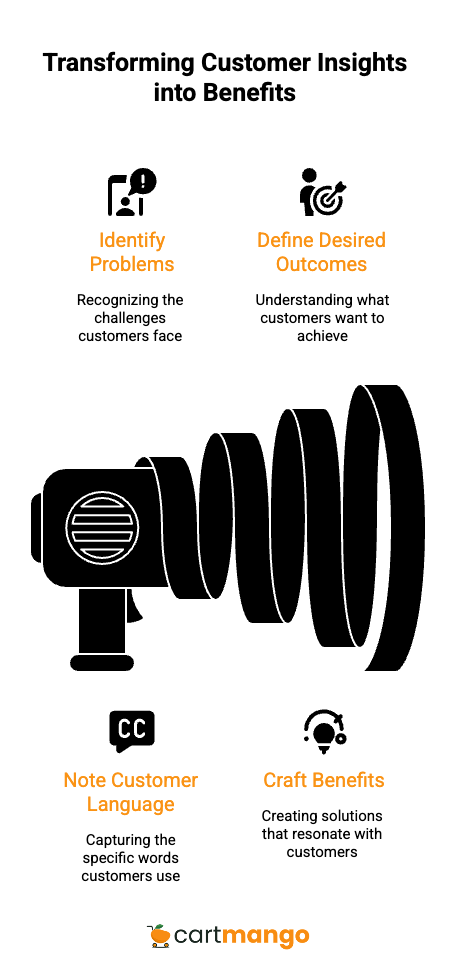
This is where discovery calls become gold.
- Listen to how your prospects describe their problems.
- What words do they use?
- What outcomes do they want?
- Write down their exact phrases.
When a prospect says “I’m drowning in setup tasks,” your benefit becomes “eliminates setup headaches.”
When they say “I need to launch faster,” your benefit becomes “go live in minutes.”
Record your sales calls if possible. Mine them for the exact phrases your customers use when describing their pain points and desired outcomes. Create a swipe file of customer language you can reference when writing copy.
Don’t assume you know how customers think about your product. I’ve seen companies completely miss the mark because they used internal jargon instead of customer language. Your engineering team might call it “API integration,” but your customers call it “connects to the tools I already use.”
–
Step 3: Anchor Outcomes with Real Numbers
Vague benefits don’t sell.
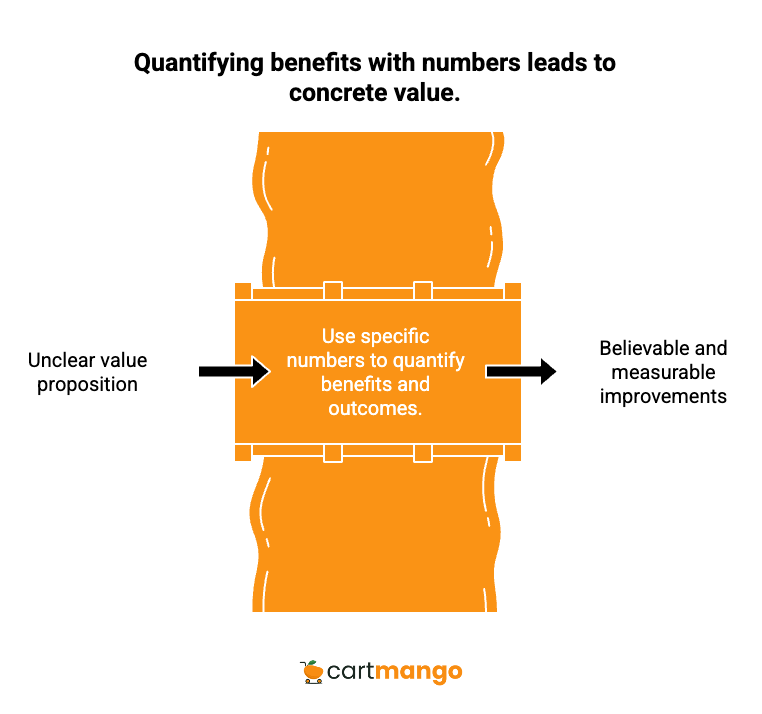
- “Saves time” is weak. “Saves 3 hours per week” is strong.
- “Reduces customer support tickets by 40%” beats “improves customer satisfaction.” Numbers make benefits concrete and believable.
Get specific about the measurable improvement your customer can expect. If you don’t have exact numbers, survey your existing customers or run a small pilot program. Send a simple email asking: “How much time does our product save you each week?”
Track before-and-after metrics when possible. If customers used to spend 2 hours setting up their store and now spend 15 minutes, that’s an 87.5% time reduction. That’s a powerful, specific benefit you can promote with confidence.
Build a library of customer success metrics.
Keep track of time saved, revenue increased, costs reduced, and stress eliminated. These become your proof points for future marketing campaigns.
–
Step 4: Prioritize and Publish Strategically
Not all benefits are created equal. Rank them by impact on your customer’s biggest pain points.
Lead with the most compelling benefit in your headlines and opening paragraphs. Save the nice-to-have benefits for later in your copy.
Test different benefit hierarchies. What resonates with enterprise customers might not work for small businesses. Segment your messaging based on customer size, industry, or use case.
Pro tip: Modern AI tools can now automatically summarize call notes to help you identify benefit language patterns. This saves hours of manual review and helps you spot trends across dozens of customer conversations.
The Only Metrics That Matter
I see too many teams tracking everything and optimizing nothing. You’re drowning in data but starving for insights. Focus on these 3 sales metrics:
Metric | Why It Matters | Formula | Cadence |
|---|---|---|---|
Total Sales Revenue | Ultimate proof messaging resonates | Sum of all payments in period | Monthly |
Lead-to-Customer Conversion Rate | Measures funnel efficiency | Customers ÷ qualified leads × 100 | Monthly |
Average Order Value | Shows upsell success | Total revenue ÷ number of orders | Monthly |
Track these religiously. If they’re moving up, your feature-to-benefit messaging is working. If they’re flat or declining, revisit your benefit language. Don’t get distracted by vanity metrics like page views.
Monthly tracking gives you enough data to spot trends without getting caught up in daily noise. Weekly tracking can lead to overreacting to normal fluctuations. I’ve seen teams change entire strategies based on one bad week.
–
Common Pitfalls That Kill Conversions
Now that you have your measurement framework in place, let’s talk about the mistakes that can derail your entire strategy.

Feature Lists Without Context
Don’t just list what your product does. Always connect features to outcomes. “Dashboard” means nothing. “See your sales performance at a glance” creates value.
Overpromising Results
Keep your numbers realistic. Saying you’ll “10x their revenue” sounds fake. Saying you’ll “reduce setup time by 30-40%” sounds believable because it’s specific and achievable.
Missing Social Proof
Benefits feel theoretical until someone else validates them. Include testimonials, case studies, or metrics from real customers wherever possible. One sentence from a happy customer beats three paragraphs of your own claims.
Wrong Pronoun Usage
Your copy should use “you” and “your” more than “we” and “our.” Make it about them, not you. This single change can improve engagement by 15-20%.
QA Checklist
Run through this checklist before any marketing asset goes live:
- Feature → Benefit → Outcome chain exists for every key point
- At least one proof point per major benefit
- Language focuses on customer outcomes
- Headlines promise results, not just tools
- Numbers are realistic and verifiable
- Testimonials include specific outcomes
- Copy uses “you” more than “we”
Feature Benefit Selling Copy Examples
SaaS Setup Example
“Skip the clunky setup process. Go live in under 5 minutes with no coding required. Spend less time configuring and more time earning.”
Breakdown:
- Feature: No-code setup
- Benefit: No technical hassles
- Outcome: More time for revenue generation
–
E-commerce Upsell Example
“Automatic upsell prompts at checkout increase average order value by 23% without feeling pushy to customers. Our AI suggests relevant add-ons based on purchase history and customer behavior.”
Breakdown:
- Feature: Automatic upsell prompts with AI suggestions
- Benefit: Increases sales without being pushy to customers
- Outcome: 23% increase in average order value
–
Customer Support Example
“Built-in help docs reduce support tickets by 35%, giving your team more time to focus on high-value customer success activities. Customers find answers instantly instead of waiting for email responses.”
Breakdown:
- Feature: Built-in help documentation system
- Benefit: Reduces support workload and provides instant answers
- Outcome: 35% reduction in support tickets + more time for high-value activities
–
Project Management Example
“Smart deadline tracking helps teams avoid up to 75% of missed deliverables in our customer studies. Your team stays on schedule while you sleep peacefully knowing nothing will slip through the cracks.”
Breakdown:
- Feature: Smart deadline tracking system
- Benefit: Keeps teams on schedule and provides peace of mind
- Outcome: Up to 75% reduction in missed deliverables
Building Your Feature Benefit Sales Strategy at Scale
Now that you’ve seen how individual copy examples work, let’s talk about implementing feature benefit selling across your entire sales process. You can’t just update a few web pages and call it done.
Your sales team needs a complete feature benefit sales strategy that every sales rep can execute consistently. This means training your sales professionals to think in terms of outcomes, not just product demonstrations.
Start by documenting how each product’s features should be presented during sales calls. Create a playbook that shows sales reps exactly how specific features translate into customer value. When your entire sales team speaks the same benefit-focused language, you’ll see measurable improvements in sales success rates.
The key is making this systematic, not leaving it to chance. Map out every stage of your sales process and identify where benefit language should replace feature lists.
Understanding Your Target Audience Beyond Demographics
You can’t create compelling benefits without truly knowing your potential customers. Too many companies think they understand their prospective customers but only scratch the surface.
Deep understanding comes from serious customer research. Survey your particular customers about their daily frustrations. What keeps them awake at 3 AM? What would make their customer’s life measurably better? This is about discovering the customer needs that your target audience feels most urgently.
Market research isn’t just about industry trends. It’s about discovering the specific needs that drive your prospective customers to seek solutions. Create detailed buyer personas that go beyond job titles and company sizes.
Talk to potential buyers who didn’t purchase from you. Why did they walk away? Their answers reveal gaps between what you think your value proposition offers and what prospective customers actually need.
Conduct customer research through recorded interviews, not just surveys. Listen for the emotional language people use when describing their problems. This becomes your benefit vocabulary.
How Features Translate Into Real Customer Impact
Here’s where most product teams get stuck. They know their product’s features inside and out, but they struggle to show how those specific features create tangible benefits in real life.
We’ve talked about this earlier. Features describe what your product does. Benefits explain what those features accomplish for users. But you need to go deeper and show how this positively impact someone’s daily experience.
Take technical specifications and strip away the technical jargon. Your product descriptions should read like stories about transformation, not engineering manuals. When features translate clearly to outcomes, technical details become supporting evidence rather than the main message.
Avoid drowning prospects in technical specifications. Instead, focus on how each feature changes the user experience. Show the before-and-after story. Paint a picture of their improved reality.
Your value proposition should emerge naturally from this translation process. When you clearly connect functionality to customer outcomes, positive outcomes become obvious and compelling.
The Power of Stories and Authentic Connections
Numbers and features matter, but a few stories can seal the deal faster than any specification sheet. Customer feedback provides the raw material for these powerful narratives.
Real world examples show your benefits in action. Don’t just tell prospects they’ll save time. Share a specific story about how Sarah reduced her setup process from 3 hours to 15 minutes and used that extra time to launch two additional products that month.
Making connections with prospects becomes easier when you have authentic stories that mirror their situation. People buy from companies that genuinely care about solving their specific problems, not just selling products.
These stories also build brand loyalty over time. When customers see themselves reflected in your success stories, they develop stronger emotional connections to your service. This emotional bond increases customer retention and drives word-of-mouth referrals.
Stories also boost self esteem for buyers who feel validated in their purchase decision. When they see others like them succeeding, they feel confident they’ve made the right choice.
Optimizing Your Tools for Maximum Impact
To bridge the gap between compelling stories and systematic execution, your product needs powerful tools that make implementing feature benefit selling highly effective for your sales team and users.
Automation is key. Build systems that help sales reps quickly identify which benefits matter most to different customer segments. Create templates that sales reps can customize for specific conversations while maintaining consistency.
Track which benefit messages drive the highest conversion rates. This data helps you close deals more predictably and refine your messaging over time.
Even seemingly unrelated benefits can matter. For example, if your software reduces server load, that’s like improved fuel efficiency for your customer’s technical infrastructure. Every efficiency gain adds up.
The goal is creating a systematic approach that any team member can execute effectively, regardless of their experience level.
Modern AI-powered tools can assist in analyzing customer feedback and sales conversations to surface the most compelling benefits automatically, making your feature benefit sales strategy more agile and data-driven.
Do It Today
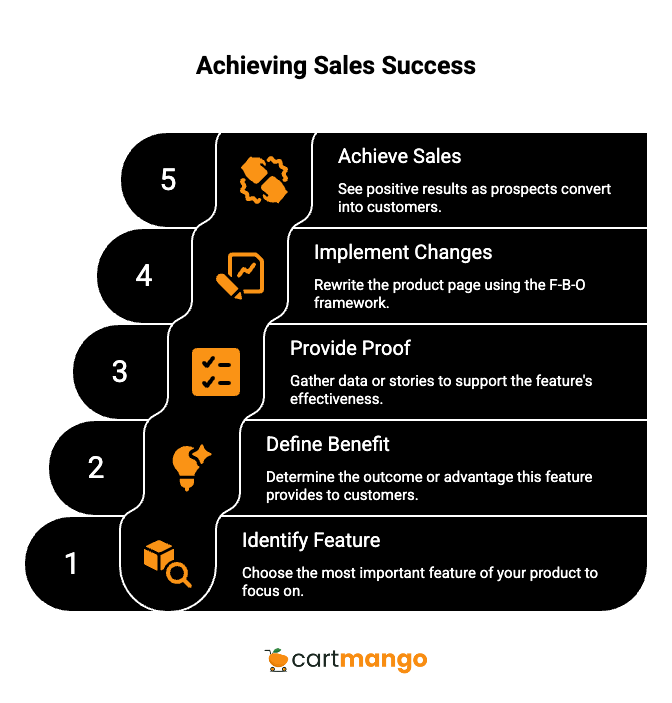
Pick 1 product page and rewrite it using the F-B-O Ladder Framework.
Start with your most important feature and work through the framework. Don’t try to perfect it. Just get the basic structure in place.
Ask yourself: What does this feature do for my customer? What outcome does that benefit create? How can I prove it with numbers or stories?
Make this change today. Your future self will thank you when those demo prospects start saying “yes” instead of disappearing into the void.
Related
- Sellfy vs Payhip: The Recurring Revenue Prison (2026)
- Podia vs Gumroad: The Recurring Revenue Handcuffs (2026)
- SendOwl vs Gumroad: The Recurring Revenue Black Hole (2026)
- Gumroad vs Sellfy: The Vendor Lock-in Cage (2025)
- Gumroad vs Payhip: The Hidden Trap for Creators (2025)
- ThriveCart vs SamCart – The Subscription Hostage Trap (2025)
- 8 ThriveCart Alternatives & The Lifetime Pricing Paradox (2025)
- 8 SamCart alternatives + Subscription hostage (2025)
- The GENTLE Method: Soft marketing for creators
- How Far in Advance Should You Promote a Webinar?
